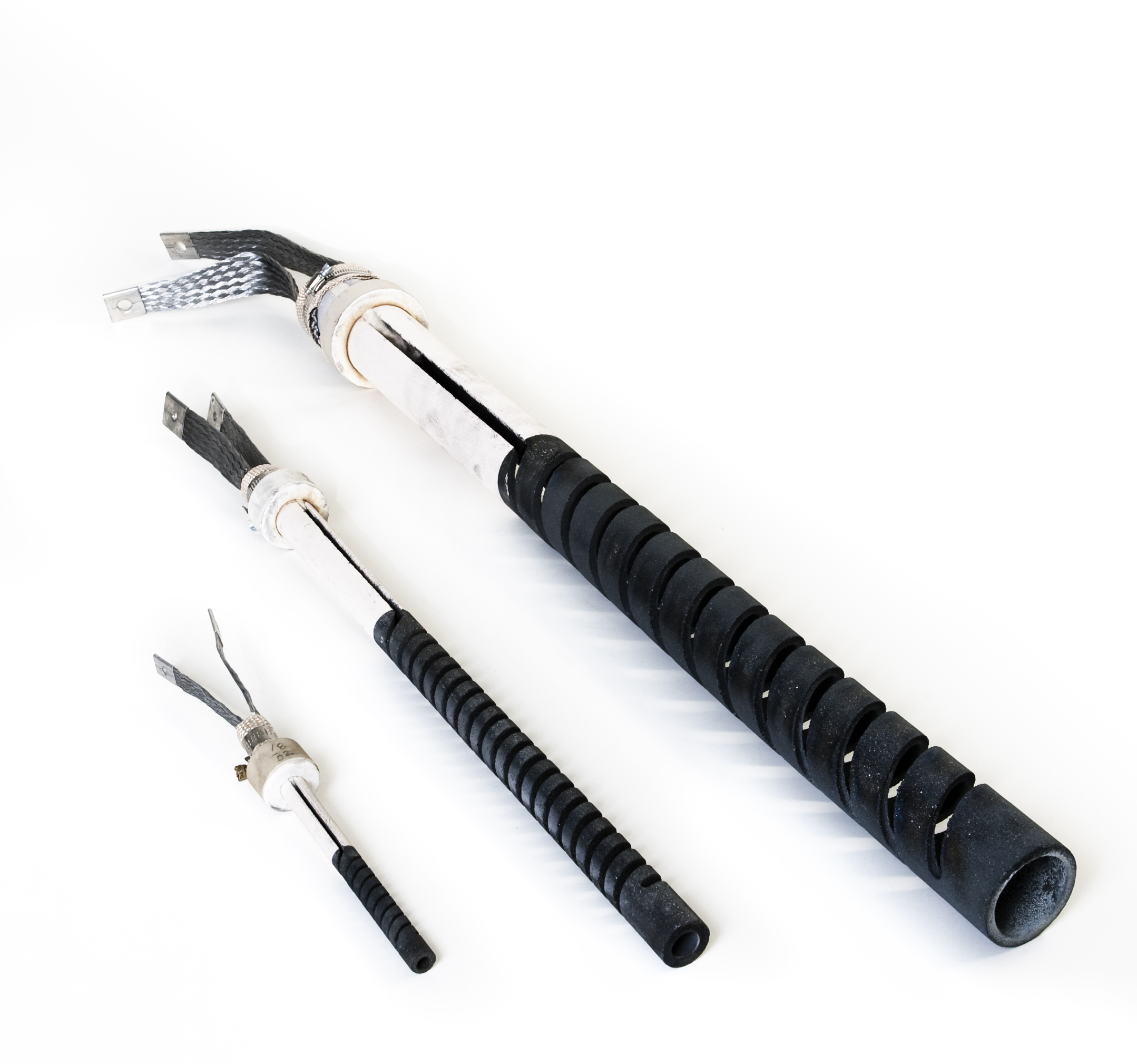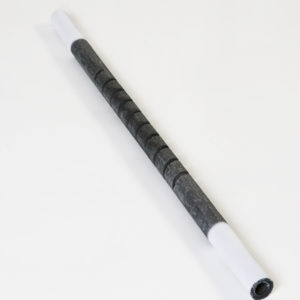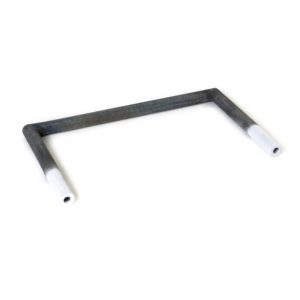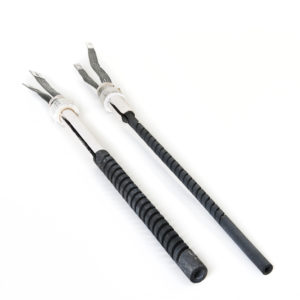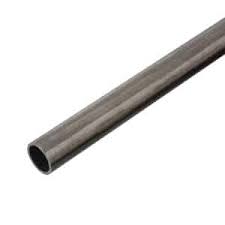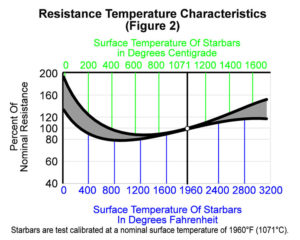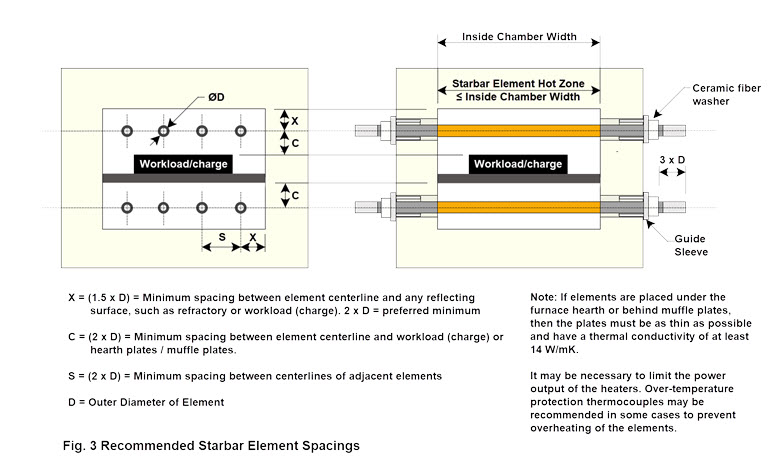Made of special high-density reaction-bonded silicon carbide, the SER Starbar is a tube with both electrical connections on one end. The hot zone is formed by cutting a double spiral slot which reduces the cross sectional area through which current flows, resulting in higher resistance than the cold end. The cold end is formed by cutting two longitudinal slots along the length of the tube. The SER element is supplied with a ceramic collar cemented to the extremities of the cold end. The cold end of the SER element is flame sprayed with aluminum for a distance of about two inches. Flat braided-aluminum straps are held in compression with stainless steel clamps to this metallized area. The clamp is electrically insulated from the flat braid with high temperature insulation. The aluminum braid is 10 inches (254 millimeters) long and holes are provided for easy connection to the power supply.
SER Brochure
(PDF, 828KB)
Sizing Breakdown
| Item # | Item Name | Nominal Diameter | Maximum Heating Length | Maximum Overall Length | Starbar ID |
|---|---|---|---|---|---|
| SER-1/2-13 | Type SER, Silicon Carbide Spiral Heating Element | 0.50 Inch 13 mm | 10 Inch 250 mm | 21 Inch 533 mm | 3/16 Inch 5 mm |
| SER-5/8-16 | Type SER, Silicon Carbide Spiral Heating Element | 5/8 Inch 16 mm | 10 Inch 250 mm | 22 Inch 559 mm | 5/16 Inch 8 mm |
| SER-3/4-19 | Type SER, Silicon Carbide Spiral Heating Element | 0.75 Inch 19 mm | 16 Inch 406 mm | 25 Inch 635 mm | 3/8 Inch 9.5 mm |
| SER-7/8-22 | Type SER, Silicon Carbide Spiral Heating Element | 7/8 Inch 22 mm | 20 Inch 508 mm | 36 Inch 914 mm | 1/2 Inch 12 mm |
| SER-1-25 | Type SER, Silicon Carbide Spiral Heating Element | 1.00 Inch 25 mm | 20 Inch 508 mm | 36 Inch 914 mm | 9/16 Inch 14 mm |
| SER-1-1/4-32 | Type SER, Silicon Carbide Spiral Heating Element | 1.25 Inch 32 mm | 20 Inch 508 mm | 39 Inch 991 mm | 11/16 Inch 17 mm |
| SER-1-3/8-35 | Type SER, Silicon Carbide Spiral Heating Element | 1-3/8 Inch 35 mm | 24 Inch 610 mm | 40 Inch 1016 mm | 13/16 Inch 21 mm |
| SER-1-1/2-38 | Type SER, Silicon Carbide Spiral Heating Element | 1.50 Inch 38 mm | 24 Inch 610 mm | 40 Inch 1016 mm | 15/16 Inch 24 mm |
| SER-1-3/4-44 | Type SER, Silicon Carbide Spiral Heating Element | 1.75 Inch 44 mm | 24 Inch 610 mm | 40 Inch 1016 mm | 1-1/16 Inch 27 mm |
| SER-2-1/8-54 | Type SER, Silicon Carbide Spiral Heating Element | 2-1/8 Inch 54 mm | 24 Inch 610 mm | 48 Inch 1219 mm | 1-5/16 Inch 33 mm |
| SER-2-3/4-70 | Type SER, Silicon Carbide Spiral Heating Element | 2.75 Inch 70 mm | 40 Inch 1016 mm | 61 Inch 1549 mm | 1-7/8 Inch 48 mm |
Mounting
SER Starbars can be mounted vertically or horizontally. When mounted horizontally, the hot end does not need to be supported. When mounting the element horizontally the slot in the terminal end should not come in contact with the insulation in the wall of the furnace or kiln. This is most easily accomplished by placing the slot in a horizontal position. The terminal holes should also be 10% larger than the diameter of the element. Extreme caution should be used when mounting to ensure that the Starbars are not placed in tension. There should be adequate freedom to allow for the furnace and Starbars to expand and contract independently.
Starbars should have their heating sections centered in the furnace chamber so that no portion of the heating section extends into the furnace wall. A conical or truncated cone shaped recess 1/2 inch (13 mm) deep is sometimes located on the interior wall where the Starbar passes through. This allows the hot zone to radiate properly and helps maintain a uniform temperature in the kiln.
Table CRecommended Minimum Refractory Hole Size |
|||
| Starbar Diameter | Recommended Minimum Refractory Hole Diameter | ||
| mm | Inch | mm | Inch |
| 13 | 1/2 | 16 | 5/8 |
| 16 | 5/8 | 19 | 3/4 |
| 19 | 3/4 | 23 | 7/8 |
| 22 | 7/8 | 27 | 1-1/16 |
| 25 | 1 | 30 | 1-3/16 |
| 32 | 1-1/4 | 39 | 1-1/2 |
| 35 | 1-3/8 | 42 | 1-5/8 |
| 38 | 1-1/2 | 42 | 1-11/16 |
| 44 | 1-3/4 | 49 | 1-15/16 |
| 54 | 2-1/8 | 60 | 2-3/8 |
| 70 | 2-3/4 | 77 | 3-1/32 |
| Recommended Minimum Refractory Hole Diameter for TSR Cold End | |||
| 44 | 1-3/4 | 49 | 1-15/16 |
| 50 | 2 | 55 | 2-1/4 |
| 55 | 2-1/8 | 61 | 2-11/16 |
| 62 | 2-1/2 | 69 | 2-3/4 |
| 75 | 3 | 84 | 3-5/16 |
Specifications
Operating Temperatures
In an air or inert atmosphere of argon or helium the SER and TSR Starbars can be operated at furnace temperatures up to 3000ºF (1650ºC). In reducing atmospheres, the maximum operating temperature is 2500ºF (1370ºC). See Recommended Maximum Watt Loading Graph, Figure 1.
There is a protective coating of silicon dioxide on the silicon carbide. Hydrogen reduces this coating and causes the Starbar to deteriorate. Nitrogen atmosphere applications are limited to 2500ºF (1370ºC) and 20 to 30 watts per square inch (3.1 to 4.6 watts per square centimeter) maximum watt loading. Higher surface temperature will result in silicon nitride formation. A thermally insulative layer forms around the Starbar resulting in very high surface temperatures which damage the Starbars
Engineering Information
Superior Performance
At 2.85 gms/cc, this high-density low-porosity element is able to survive severe environments. The high density prevents the internal lattice structure from being oxidized. This element therefore has an extremely slow aging characteristic.
Interchangeability
Starbars are premier grade high performance silicon carbide elements, and the only silicon carbide heating elements manufactured in the United States. Starbars can also be manufactured in special sizes and resistance values to replace elements supplied by other manufacturers in Asia and Europe. It is important to provide the nominal electrical resistance when ordering Starbars. Please contact us, before attempting to substitute the RR Starbars for spiral type SE/SER Starbars.
Aluminum Braid Information
- The working length of the SER and TSR aluminum braid is 10 inch (254 mm).
- The end clip hole diameter for 50 amp braid is 9/32 inch (7 mm), for 100 amp braid and higher is 9/16 inch (14 mm).
- The amperage rating of the aluminum braid according to diameter is 1/2 inch (13 mm) to 1 inch (25 mm) diameter – 50 amps, 1-1/4 inch (32 mm) to 2-1/8 inch (54 mm) diameter – 100 amps, 2-3/4 inch (70 mm) diameter – 400 amps, TSR elements – 1-3/4 inch (44 mm) to 2-1/2 inch (62 mm)
Electrical Characteristics
The silicon carbide Starbar is a linear type resistance heater that converts electrical energy to heat energy – Joule’s Law W = I^2 x R, (W = power in watts, I = current in amperes, R = resistance in ohms). The SER Starbar has a negative resistance.
Electrical Loading
Starbars are not sized to a specific wattage output like metallic heating elements. The amount of energy that a Starbar is capable of converting from electrical to heat energy depends on the ambient furnace temperature and atmosphere in which the Starbar
Power Supply
The previous paragraph explained how to calculate the recommended wattage output of the Starbar. The following explains how to compute the electrical requirements to provide the recommended power.
Knowing the wattage output and the resistance of the Starbar you have two parts of an equation with three unknowns. This equation is V = √(W x R), (V = nominal full load voltage, W = rating of the Starbar in watts, R = resistance of the Starbar in ohms). The resistance of the Starbar can be calculated using the values found in Table B. Solving for V determines the voltage required on a nominal-resistance Starbar to provide the wattage output desired. This assumes a nominal resistance.
Example: A Starbar SER 24 x 16 x 1.25 has a resistance of 5.76 ohms and 63 square inches of radiating surface. Loading to 40 watts per square inch this Starbar could provide 2500 watts. To find the nominal voltage solve for V.
V = √(W x R)
V = √(2500 x 5.76)
V = 120 volts
Starbars may be connected in parallel, series, or any combination thereof. Parallel connections are preferred because if the resistance of one or more Starbars increases, its portion of the load will be reduced and the group will remain in balance.
In a parallel arrangement the voltage across all the Starbars is the same. In the formula W = V²÷R (W = watts, V = voltage, R = resistance) it can be seen that, the greater the resistance, the lower the wattage output. The Starbars in the parallel circuit with the lowest resistance will supply more heat energy and therefore operate at a higher temperature.
This higher Starbar temperature will cause it to gradually increase in resistance until all the Starbars have the same resistance. At this time all the Starbars should have approximately the same resistance values and surface temperatures and therefore remain in balance.
To compute the network resistance of a group of Starbars the following formula may be used: Rn = R x S ÷ P (Rn = network resistance, R = resistance of Starbar, S = number of Starbars connected in a series, P = number of parallel circuits).
Example: Eight Starbars SER 24 x 16 x 1.25 (R = 5.76 ohms) connected 2 in series (S = 2) and 4 parallel groups (P = 4).
Rn = R x S ÷ P
Rn = 5.76 x 2 ÷ 4
Rn = 2.88 ohms
To compute the nominal network voltage required to power a set of Starbars, a combination of the previous two formulas is used as follows: Vn = √(Wt x Rn), (Vn = nominal network voltage, Rn = network resistance, Wt = total wattage output).
Example: Eight Starbars SER 24 x 16 x 1.25 (R = 5.76 ohms) connected 2 in series, 4 parallel groups. Each Starbar provides 2500 watts. Wt = 8 x 2500 = 20,000 watts. Rn = 2.88 ohms.
Vn = √ (Wt x Rn)
Vn = √ (20,000 x 2.88)
Vn = 240 volts
The resistance of Starbars increases gradually during their useful life. Therefore some means of keeping the power input to the kiln or furnace at a level sufficiently high to maintain the desired temperature is required.
Historically, expensive voltage varying equipment such as multiple tap transformers or saturable reactors were recommended for all but the very low temperature applications.
Spiral Starbars can be used directly on the line (fixed voltages) at temperatures up to 2500ºF (1370ºC). To compensate for the reduced output as the Starbars gradually age or increase in resistance, the furnace or kiln is initially overpowered by 25% to 50%. This type of arrangement eliminates the expensive voltage varying equipment and has proven very satisfactory in many applications. It is not recommended when fine process temperature control is required.
Assume a furnace will require approximately 20,000 watts after all heat losses and load factors have been considered. Increasing this 20,000 by 25% to 50% gives a wattage requirement of between 25,000 and 30,000 watts.
By taking another look at the previous examples it can be seen that 10 Starbars SER 24 x 16 x 1.25 connected two in series, five parallel groups on 240 volts would supply 25,000 watts. If 12 Starbars of the same size Starbars were used, the output would be 30,000 watts.
Twelve Starbars connected four in series, per phase, in a delta, on 240 volts would make a balanced three phase 240 volt network.
The temperature of the kiln or furnace is controlled by an off-on controller. When the Starbars are new, they will only be powered for 20/25 or 20/30 of the time (the ratio of the power needed to the power available). As the Starbars increase in resistance, they will be on for a greater percentage of the time. When they have increased in resistance to a point at which they supply 30,000 watts, they will be on 100% of the time. A SCR (silicon controlled rectifier) or thyristor can also be used.
For applications where close temperature control is desired and/or for temperatures above 2500ºF (1370ºC), a device for increasing the voltage to the Starbars is required.
There are several methods of providing this variable voltage source.
(1) The multiple tap transformer was historically the most common. The secondary of the transformer is provided with taps, which usually vary in number from 10 to 36. By carefully selecting the voltage taps, the correct voltage output to match the resistance of the Starbars over their complete useful life can be made.
(2) Silicon controlled rectifiers (SCR, also known as a thyristor stack or thyristor unit) have become increasingly popular, as they offer precise fine control of the voltage input to the heating elements.
(3) A combination of transformers and SCRs, whereby the transformers are used to match the requirements of the load to the voltage supply, but having far fewer taps than conventional transformer only systems, typically 3 to 4 taps only, with the SCR providing the fine control between tap changes.
To compensate for the reduced output as the Starbars increase in resistance, a voltage range is required that will compensate for a 100% increase in the Starbar’s resistance. The following formula may be used to figure Vmax: Vmax = √(Wt x Rn) x 1.5, (Vmax = recommended maximum voltage required to compensate for increase in resistance due to aging and resistance tolerance, Wt = rating of transformer in watts, Rn = network resistance of the Starbars, 1.5 = minimum margin to accommodate the doubling of the Starbar network resistance and the plus 20% resistance tolerance). A higher value will offer slightly longer usable service life.
Example: A transformer is rated at 24 KVA and has a computed nominal full load voltage of 240 volts. (Rn = 2.88, Wt = 20,000 for 8 Starbars)
Vmax = √(Wt x Rn) x 1.5
Vmax = √(20,000 x 2.88) x 1.5
Vmax = √(57,600) x 1.5
Vmax = 360 volts
The nominal full load voltage and maximum voltage have been computed.
When specifying the transformer, the nominal full load voltage is usually reduced to allow for the minus 20% resistance tolerance of the Starbars and slow furnace heatup.
To calculate the minimum voltage, take 70% of the nominal voltage. For periodic applications, take 30% of the nominal full load voltage.
When computing the size of the voltage steps between taps, a value of 5% of the nominal full load voltage is often used. When SCR or thyristor controls are used on the primary, fewer taps are required. For example, if 6 taps are used, the idling tap can be 0.7 x nominal voltage, then each consecutive tap would be 14% higher. For 8 taps, the idling tap would again be 0.7 x nominal voltage, each consecutive tap at 9.1% higher than the preceding.
Ease of Replacement
SER Starbars can be replaced while the furnace is at operating temperature. The power to the Starbars being changed should be shut off, the aluminum braids disconnected from the buss, and the old Starbars removed. The new Starbar should be inserted smoothly through the hot furnace but not so fast as to cause thermal shock.
Service Life
Starbars increase gradually in resistance with use. This characteristic of increasing in resistance is called aging. Aging is a function of the following:
- Operating temperature
- Electrical loading – usually expressed in watts per square inch or watts per square centimeter of Starbar radiating surface
- Atmosphere
- Type of operation (continuous or intermittent)
- Operating and maintenance techniques
Furnace Heating Chamber
The furnace heated chamber dimension, which the Starbar spans, can be the same as the Starbar hot zone as shown in Figure 3 and Figure 4. The recommended terminal hole diameter is calculated by increasing the Starbar outer diameter by 20% for sizes up to and including 1-3/8 inch (35 mm), and a 10% increase for larger sizes. Table C shows these recommended minimum refractory hole diameters based on the Starbar size.
Starbars should not be placed closer than two Starbar diameters to each other or one and one half Starbar diameter to a wall or other reflecting body. If the Starbar is not able to dissipate heat energy equally in all directions, it may overheat and possibly fail.
The formula for computing the recommended Starbar spacing to obtain an even temperature gradient on the product being heated is shown in Figure 3.
Recommended Starbar spacing
Specifications and Matching
Starbars have a manufactured tolerance of plus or minus 20% on the nominal resistance. All Starbars are calibrated at least twice prior to shipping to ensure their being within specifications. The calibrated amperage of each Starbar is marked on the carton and collar of each Starbar. When installing, arrange Starbars with amperage values as close to each other as available. Longer service life will be obtained when series connected Starbars are matched in resistance. Starbars are shipped as closely matched as possible.
Availability
Starbars can be shipped from stock, or two to three weeks after receipt of an order.
Custom Configurations
The ID of the SER cold end is normally plugged. Alternatively, the SER is available with a clear ID which allows it to be used as a tube heater. The SER should be used as a tube heater rather than the TSR whenever possible because the wall is thicker making it stronger. The TSR should be used only when the SER ID is not large enough.
Special higher electrical resistance values are available. This is accomplished by machining a smaller spiral width. Therefore, very high resistance and/or long hot zone lengths are not practical. Lower than standard resistances are not recommended.
REQUEST INFORMATION

